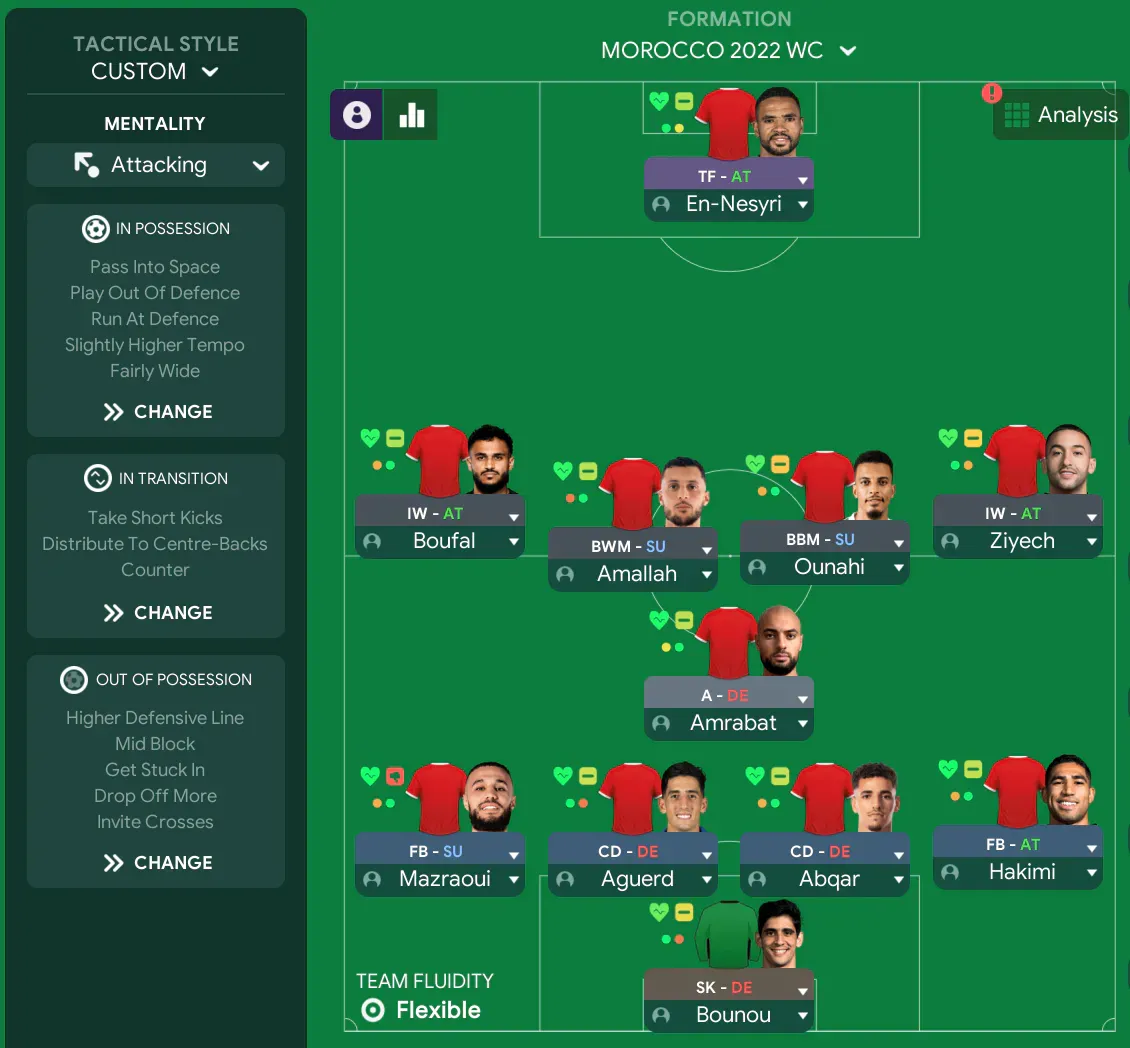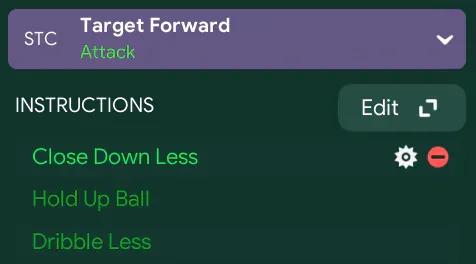Morocco stunned the world with their rock-solid defence and tactical
brilliance—now you can recreate their success in FM24!
Included in Premium Members Area: Extra Downloads
& Benefits
Premium: Extra Benefits
When legendary striker Samuel Eto’o released his predictions for the 2022 World Cup in Qatar, he became the subject of public mocking and humiliation as he predicted three African teams to reach the World Cup Semi-Final stage, despite the fact that no African team had reached that stage of a World Cup since Cameroon’s phenomenal ’90 campaign. It was Eto’o, however, who had the last laugh as one of the three African teams he predicted to reach the Semi-Finals, Morocco, magnificently made the last 4 after beating the likes of Portugal, Spain and Belgium! In this article, I’ll be providing my brief analysis of the tactics Morocco used to achieve this incredible feat, before showcasing my recreation of said tactics in Football Manager 2024 and demonstrating the results achieved in testing with this tactic! Firstly, let’s have a look at the core principles of this system!
Incredibly Drilled Compact Mid-Low Block
Coming into the tournament as one of the underdogs, Morocco’s manager Walid Regragui, who had only joined the National Team fold a few months prior, made sure to use his small amount of time on the training pitch to drill one of the most compact mid-low blocks you’ll see. From within this mid-low block, he’d ask his team to sit incredibly narrow to close the gaps between each player and ultimately force the opposition into wide areas, where his team could then move over to the flanks in a tight unit to block off progressive passing options down the line. This would often result in opposition teams simply passing the ball between their back-line as they patiently wait for a potential opening – an opening which would very rarely open up. When the opposition would try and pass the ball centrally, Morocco’s midfield would hound the player receiving the ball, leaving him with only one option and that’s passing backwards. This mid-low block did bear fruits, as the team only conceded ONE goal in their run to the Semi-Finals, and that was an unfortunate own-goal in a 1-2 victory over Canada in the Group Stages.
Marking Zones Rather Than Players
Most teams in modern football will tend to defend using one of these two different styles: ‘Zonal Marking’ or ‘Man Marking’. Morocco, despite the initial comparisons drawn with the term ‘zonal’, wouldn’t use either style to defend. That’s because, whilst Morocco would defend ‘zones’ like the term ‘zonal marking’ suggests, Morocco would mark different type of zones. The term ‘zonal marking’ means your players will mark a zone which is assigned to them, for example, if a team defended in a 4-4-2 formation, one of the two central midfielders will be tasked with marking the zone in which they are positioned, as demonstrated below:

|
| Black square indicates zone the midfielder will mark in a classic ‘zonal marking’ system. |

|
| Picture: Coaches Voice |
Let’s Break Down the Tactic
In Possession
When Morocco had possession, they’d primarily look to build up play from the back in order to maximise their time on the ball and retain control of possession. Once they had progressed from the build-up phase, they would look to play the ball to their tricky wingers who’d have the responsibility to carry the ball forward and use their creativity to progress play higher up the pitch. Morocco’s possession would consist of varied passing ranges at a slightly quicker pace.
In Transition
When Morocco lost the ball, their players would have to decide whether to counter-press or drop deeper based on the game’s situation. When Morocco won back possession, they’d look to counter-attack immediately to try and punish the opposition who could be in a poor transitional shape. From goal-kicks, Bounou would usually pass the ball short to the centre-backs – if this option was not optimal, Bounou would rather go long towards En-Neysri who’d look to use his strength and height to retain possession and/or flick the ball into an area for team-mates to duel.
Out of Possession
When Morocco didn’t have the ball for sustained periods, they’d retreat into a very dense mid-block based on marking specific zones, as aforementioned. To compact the midfield space, Morocco would play a higher line, however, their back-line could drop off to maintain a solid defensive shape if the midfield was penetrated by the opposition. If the ball went into an advanced wide area, Morocco would usually allow crosses to be put in as Bounou was excellent at claiming stary crosses into the box.
Opposition Instructions
Player Roles
Sweeper Keeper – Defend
In this position, Bounou would rarely offer a passing option for his centre-backs and was only used as a last resort to bypass an opposition press. When Morocco didn’t have the ball, Bounou could sweep when needed and could regularly leave his line to collect stray crosses into the box. Therefore, I felt this role was perfect. No additional instructions.
Full-Back – Attack
Whilst both full-backs, in this system, were quite like traditional full-backs who’d focus on doing their defensive job to the highest calibre, Hakimi would naturally position himself higher and could be used as a secondary option to progress play and could overlap Ziyech on the right-side. When he would move higher with the ball, he’d look to reach the byline to work cut-back/crossing situations. Therefore, I felt this role was ideal, with the added instructions:
(DCR & DCL) Central Defender – Defend
Both centre-backs in this system had very simple roles: Defend. Neither centre-back were particularly aggressive/cautious in their defending, nor were they particularly progressive and adventurous with the ball at their feet. Both centre-backs would prefer the simple pass and would focus on successfully defending and winning their duels. Therefore, I felt this role was perfect. No additional instructions on either position.
Full-Back – Support
The left-back in this system, usually Mazraoui, was the more cautious of the two full-backs and would typically hold a deeper position to offer a sideways passing option. The only slight nuance in his more traditional full-back role was the fact that, when he was higher up the pitch, he’d regularly cross the ball for En-Neysri to attack. Therefore, I felt this role was suitable, with the added instruction:
Anchor – Defend
In this position, Amrabat’s role was focused on marking and defending his specific, as demonstrated earlier in the article. However, when Morocco had the ball, he could offer himself as a central passing option and use his progressive passing ability to spot players positioned higher, opting for a more direct passing range on occasion. Therefore, I felt this role was perfect, with the added instructions:
(The position specifically marked is: ‘AMC’)
Ball-Winning Midfielder – Support
In this position, Amallah would look to situationally support attacks, however, would typically hold a slightly deeper position to maintain defensive structure for any forthcoming opposition counter-attacks. When Morocco didn’t have the ball, he’d regularly break from his position to close down the player on the ball on his side (usually the opposition’s right-sided centre-back) before sprinting back into position. Therefore, I felt this role was perfect. No additional instructions.
Box-to-Box Midfielder – Support
In this position, Ounahi was a clear standout in the tournament as his ranged skillset was demonstrated on multiple occasions – his impressive campaign reportedly drew the attention of many top European clubs for the following Winter transfer window. When he was given the ball, Ounahi showed immense close control and skill to carry the ball forward, before showcasing his splendid vision to find team-mates with penetrative passes. When he didn’t have the ball, Ounahi would drift from box-to-box to contribute both defensively and offensively. Like Amallah, when Morocco didn’t have the ball, Ounahi would sometimes look to break his position to press the player with the ball, however, this wasn’t as frequent. Therefore, I felt this role was perfect, with the added instructions:
(MR) Inverted Winger – Attack
In this position, Ziyech naturally held the key to most of Morocco’s creativity and would regularly look to put his majestic creativity to good use through creative passes and excellent vision to switch the play. In this system, Ziyech was given licence to deviate from his position to move into ideal positions to create for his team-mates. Finally, when Morocco didn’t have the ball, Ziyech would rarely press the opposition, opting to retain a solid defensive shape. Therefore, I felt this role was suitable, with the added instructions:
(ML) Inverted Winger – Attack
Boufal’s role in this system was slightly different to Ziyech’s, as Boufal would be more direct with the ball and look to take on his man. This would see him opt for crosses into the box once he reached a suitable position on the flank to do so. As with Ziyech, Boufal would rarely press the opposition in order to retain a solid defensive shape. Therefore, I felt this role was ideal, with the added instructions:
Target Forward – Attack
In this position, En-Neysri’s job was rather simple: Hold-up play, link with his team-mates, regularly engage in aerial duels and situationally make runs in-behind for his team-mates to find. When Morocco didn’t have the ball, En-Neysri rarely pressed. Instead, he’d move from centre-back to centre-back to use his cover shadow to cut off passes into an opposition single-pivot. Therefore, I felt this role was perfect, with the added instruction:
Results
Testing this tactic with Morocco would take too long and I wouldn’t have enough games & results to make sure this tactic was foolproof, so I decided to test the tactic with Everton – currently 16th in the Premier League at the time of writing and predicted to finish 11th in the Season Preview.
Premier League
In the Premier League, we overperformed massively as we WON the league by 6 points! Of the 38 Premier League games, we won 25 games, drew 10 games and lost just 3 games. We ended up scoring 73 goals, ranking joint-2nd in the Premier League and conceded just 23 goals, the least goals conceded by a team in the league!
Domestic Cups
The Premier League wasn’t our only shocking success, as we ended up winning the Carabao Cup! A spectacular 0-4 win against Tottenham Hotspur in the final won us the trophy, following spectacular wins against Man City, Arsenal and Liverpool on the way to Wembley. We were unable to make it a treble, following an unfortunate 2-1 defeat against Bournemouth in the Fifth Round, which was especially infuriating considering we beat Arsenal 0-1 at the Emirates in the round prior.
Conclusion
The outstanding Morocco side of ’22 will forever be etched in the history of African football following their famous World Cup campaign, in which they became the first African team to reach the Semi-Finals of a World Cup since Cameroon in 1990. Walid Regragui and his team of marvellous Moroccans introduced an ingenious defensive strategy which almost took the team all the way to World Cup glory, and in this article, I have provided my brief analysis of the strategy, along with the tactics used by Regragui and Morocco to achieve their fantastic feat, and recreated the strategy and tactics on Football Manager 2024 – said tactics can be downloaded using the link attached to this article. I hope you have enjoyed reading this article, and I wish you all the best on your FM24 saves using this tactic! Thanks for reading!


















%20Inverted%20Winger%20%E2%80%93%20Attack.webp)
%20Inverted%20Winger%20%E2%80%93%20Attack.webp)














